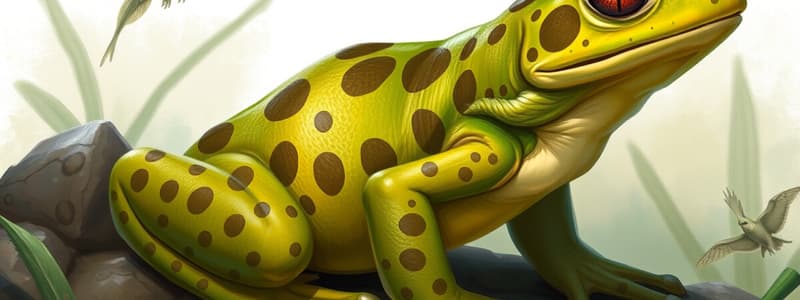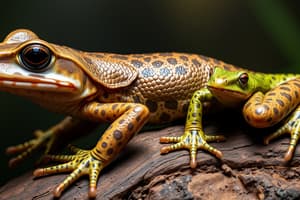Podcast
Questions and Answers
What is Acanthostega known as?
What is Acanthostega known as?
- A type of fish
- One of the earliest known Devonian tetrapods (correct)
- A type of amphibian
- An extinct lizard
What class contains all amphibians?
What class contains all amphibians?
Amphibia
Which order contains frogs and toads?
Which order contains frogs and toads?
Anura
What order do caecilians belong to?
What order do caecilians belong to?
Which order includes salamanders, newts, and mudpuppies?
Which order includes salamanders, newts, and mudpuppies?
What phylum contains all amphibians?
What phylum contains all amphibians?
What is Eusthenopteron known for?
What is Eusthenopteron known for?
What transitional fossil has adaptations for terrestrial life?
What transitional fossil has adaptations for terrestrial life?
What are Tetrapoda?
What are Tetrapoda?
What is Tiktaalik known for?
What is Tiktaalik known for?
What subphylum contains all amphibians?
What subphylum contains all amphibians?
Flashcards are hidden until you start studying
Study Notes
Classification of Amphibians Study Notes
-
Acanthostega: An early Devonian tetrapod known for well-formed limbs with distinct digits on both forelimbs and hind limbs, indicative of the evolutionary transition from aquatic to terrestrial life.
-
Amphibia: The class that encompasses all amphibians, characterized by their dual life stages, including both aquatic larval and terrestrial adult forms.
-
Anura: The order comprising frogs and toads, recognized for their jumping abilities, smooth or bumpy skin, and adaptations to various habitats.
-
Apoda: The order that includes caecilians, which are legless and burrowing amphibians, adapted for a subterranean lifestyle.
-
Caudata: The order containing salamanders, newts, and mudpuppies, noted for their elongated bodies, tails, and the ability to regenerate lost limbs.
-
Chordata: The phylum classifying all amphibians, characterized by the presence of a notochord, dorsal nerve cord, and pharyngeal slits at some stage of development.
-
Eusthenopteron: A late Devonian lobe-finned fish exhibiting key limb structures, including an upper arm bone and two forearm bones, marking an important step in vertebrate evolution.
-
Ichthyostega: A significant transitional fossil featuring a developed shoulder girdle, robust limb bones, and muscles, showcasing adaptations essential for life on land.
-
Tetrapoda: A clade of animals distinguished by four limbs, important in the evolution of vertebrates adapting to terrestrial environments.
-
Tiktaalik: A crucial transitional fossil that displays morphological features bridging lobe-finned fish and early tetrapods, highlighting the evolutionary shift towards land-dwelling lifestyles.
-
Vertebrata: The subphylum that includes all amphibians, defined by the presence of a backbone and a complex nervous system, facilitating advanced movement and sensory capabilities.
Studying That Suits You
Use AI to generate personalized quizzes and flashcards to suit your learning preferences.




